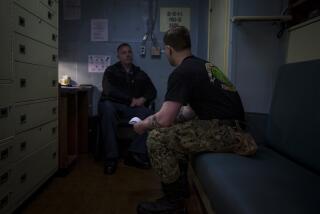Here’s How to Avoid Sickness at Sea
- Share via
Everyone, it seems, has a remedy for seasickness.
Folk medicine prescribes eating ginger root or olives. Acupuncturists suggest wearing a leather band around the arm just above the wrist. Ships’ bartenders recommend sipping either brandy and port, or creme de menthe with bitters.
A book about cruise ships advises keeping the stomach empty. An old British medical journal suggests, “cold pork and chutney or corned beef and pickles will sometimes stay down when the daintiest substances the pantry can prepare are promptly rejected.”
If these don’t sound particularly appealing, take heart. There are other effective, scientific remedies for seasickness that range from common-sense eating to prescription medicine.
Ironically, much has been discovered about seasickness from the space program. Motion sickness--a frequent problem for astronauts--occurs when the brain receives erratic stimulation, prompted by movement, of the sensory receptors that regulate balance.
When a ship rolls or pitches it moves the liquid in the semicircular canals and chambers of the inner ear. This stimulates receptors to various parts of the nervous system and some of these nerves connect with the part of the brain that triggers nausea.
Continuous mixed signals can cause the brain to send out impulses for symptoms that are uncalled for: headache, dizziness, nausea and vomiting.
What’s the best way to avoid seasickness?
--Choose a cabin near the middle, most stable, part of the ship.
--Avoid fatigue and minimize drinking and smoking.
--Avoid small, closed spaces.
If you feel ill:
--Stay in fresh air with your eyes focused on the horizon.
--Apply an ice bag or cold cloths to the forehead and back of the neck.
--Avoid strong odors and spicy or greasy foods that may unsettle the stomach.
--Take slow, deep breaths.
--Avoid reading.
--Avoid citrus juices because the acidity can further irritate the lining of the esophagus and the pulp is difficult to digest.
--If possible, eat small but frequent amounts of dry foods such as soda crackers to help settle the stomach.
--Don’t drink carbonated beverages such as cola or ginger ale. Carbonation can bloat an already upset stomach and may prompt more vomiting.
Apple and grape juice at room temperature may be better choices. If you must, drink soft drinks only after they are flat.
--Medication can be effective. Over-the-counter items available are antihistamines such as: Bonine, Dramamine, Benadryl and Phenergan.
Most antihistamines can be given to children 2 years of age and older. Check the package insert or ask your physician. Several of the medications are available in liquid form or chewable tablets.
Another drug, Phenergan, is available through injection and can be useful for treatment of severe symptoms. Ship’s physicians usually stock it.
Astronauts use scopolamine and many ships’ physicians prescribe it. Scopolamine is the active ingredient in Transderm-Scop, the tiny disks that are placed on the skin behind the ear and are effective for two to three days.
Scopolamine may cause dryness of the mouth, dizziness, drowsiness and, at times, hallucinations. Such symptoms are more frequent in the elderly. Transderm-Scop is not recommended for children under 13.
After applying a disk, wash your hands with soap and water. If you rub your eyes with traces of scopolamine on your fingers, your pupils will dilate and you will experience temporary blurring of vision.
If you sail on a cruise ship you probably won’t need medication for seasickness.
Cruise lines generally choose itineraries designed for smooth sailing by using weather reports and the ship’s radar readings to avoid choppy seas.
If a ship runs into bad weather it can use stabilizers to minimize roll and pitch. Also, ships are air-conditioned and well ventilated, eliminating stuffiness that tends to encourage seasickness.
No one knows why one person gets seasick and another doesn’t.
One way you can test your susceptibility is to read a newspaper in a moving car. If that doesn’t bother you, chances are good that you will not be susceptible to seasickness.
Children, generally those under 2, rarely become seasick and older children are less affected than adults. So if you take the children along, chances are they’ll feel fine.






